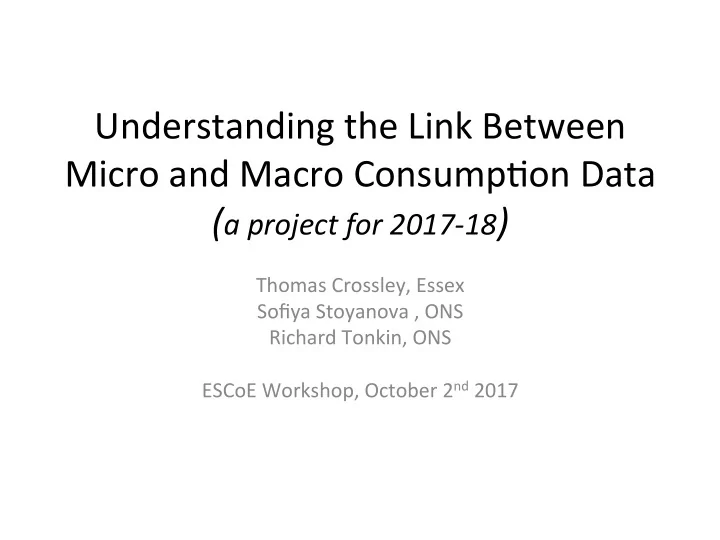

Understanding the Link Between Micro and Macro Consump8on Data ( a project for 2017-18 ) Thomas Crossley, Essex Sofiya Stoyanova , ONS Richard Tonkin, ONS ESCoE Workshop, October 2 nd 2017
Mo8va8on(s) • At least three: – Understanding the distribu8on of headline growth – Understanding macroeconomic developments and tes8ng macro models – Assessing micro-data
Distribu8onal Na8onal Accounts • Distribu8on of growth • Following S8glitz et al., 2009 (see also, OECD, 2013, ONS 2014, PikeYy et al., 2015 and Fixler et al, 2016). • Take the micro-data to NA concepts and totals – Appor8on headline growth figures – Interna8onal comparisons
Understanding Macroeconomic Developments • Many macroeconomic phenomena admit mul8ple explana8ons – Eg. Increase in household saving a]er financial crisis • Difficult to dis8nguish different models from aggregate 8me series • Micro-data would help (age, cohort, educa8on employment … ..), but • Not credible if inconsistent with aggregate data
Saving on a Rainy Day Source: Alan, Crossley and Low, (2012)
Understanding Macroeconomic Developments 16% 14% 12% HSR (Nat. Acc.) 10% Saving Rate 8% 6% EFS/LCFS 4% 2% 0% -2% Year • Source: Crossley&O’Dea (2010) • From 1992 to Financial Crisis the correla8on is -0.7
Increasing Disparity Between Micro and Macro Consump8on • Ra8o of aggregated micro-data to na8onal accounts total for consump8on expenditure • Source: BarreY et al. , 2015 (calcula8ons due to the authors)
Understanding Macroeconomic Developments • NA concepts deviate considerable from household cash flows (Cynamon & Fazzari, 2017) • Micro-concept much closer to what households observe and choose – Therefore superior for tes8ng micro-founda8ons of macro based on household behaviour – Perceived living standards
Assessing Micro-data • Considerable recent worry about the quality of data from household surveys (Meyer et al., 2015) • For household budget surveys (consump8on) under-repor8ng is key concern • Fewer comparators than income – compare to NA (eg. BarreY et al, 2015; Passero et al, 2015)
Different Approaches for Different Purposes Distribu8onal Na8onal Accounts Na8onal Micro Accounts Data Assess survey under-repor8ng? Micro-data for Macro research
Previous ONS Work • Distribu8onal accounts for household income and consump8on (ONS, 2015; Zwijnenburg et al, 2017) – part of an OECD working group – micro data taken to the NA concept, and then scaled to NA totals, – NA totals appor8oned to groups of households. • Experimental alterna8ve measures of disposable income and the household saving ra8o (ONS, 2017). – exclude transac8ons that are imputed or unobserved by households è household cash flow basis
Coverage by Category
Alterna8ve Measure of the Saving Ra8o
Worries About Propor8onal Scaling Source: Brzozowski & Crossley (2011)
Our plans “Further light would be shed on the factors behind the discrepancy by means of a reconciliaBon between the FES/EFS data and the figures produced in the naBonal accounts, but that can be provided only by the Office for NaBonal StaBsBcs” - Weale (2009)
Our plans • Build on two exis8ng strands of ONS work • Exploit newly available NPISH-Household sector split • Consider alterna8ve reconcilia8ons • Alterna8ves to propor8onal scaling • Document adjustments to raw household spending data (eg. balancing) in the produc8on of na8onal accounts – BeYer understanding of discrepancies – Start with food and clothing & footwear
Ul8mate goals • Best possible micro-data for studying macroeconomic developments • BeYer assessment of micro data and possible feedback to design and produc8on of micro data
Thank you • lcrossley@gmail.com • Sofiya.Stoyanova@ons.gsi.gov.uk • richard.tonkin@ons.gov.uk
References • BarreY, Garry, Peter Levell, and Kevin Milligan. "A Comparison of Micro and Macro Expenditure Measures across Countries Using Differing Survey Methods." in Carroll, C. D., Crossley, T.F. & Sabelhaus, J. Improving the Measurement of Consumer Expenditures, NBER Studies in Income and Wealth Vol. 74 (2015): 263-286 • Brzozowski, M. and T.F. Crossley, (2011), “Measuring the Well-being of the Poor with Income or Consump8on: A Canadian Perspec8ve,” Canadian Journal of Economics . 44(1):88-106. • Crossley and O’Dea, 2010 (Figure B1). “The wealth and saving of UK families on the eve of the crisis", IFS Report no. 71. hYp://www.ifs.org.uk/publica8ons/5200 • Cynamon, B.Z and S.M. Fazzari, (2017). “Household Income, Demand, and Saving: Deriving Macro Data With Micro Data Concepts.” Review of Income and Wealth , 63(1):1475-4991 • Fixler, D., D. Johnson, A. Craig and K. Furlong. “A Consistent Data Series to Evaluate Growth and Inequality in the Na8onal Accounts” Na8onal Poverty Center Working Paper Series #16-04. University of Michigan. (July, 2016) • Meyer, B., Mok, W., & Sullivan, J. (2015). Household Surveys in Crisis. The Journal of Economic PerspecBves, 29 (4), 199-226. • OECD (2013), OECD Framework for Sta8s8cs on the Distribu8on of Household Income, Consump8on and Wealth, OECD Publishing. • ONS (2014) Economic Well-being, Framework and Indicators • ONS (2015) The Distribu8on of Household Income, Consump8on and Savings, an OECD study. • ONS, (2017) Alterna8ve measures of UK real household disposable income and the saving ra8o: Mar 2017 • Passero, William, Thesia I. Garner, and Clinton McCully. "Understanding the Rela8onship: CE Survey and PCE" in Carroll, C. D., Crossley, T.F. & Sabelhaus, J. Improving the Measurement of Consumer Expenditures, NBER Studies in Income and Wealth Vol. 74 (2015): 181-203. • PikeYy,T., E. Saez and G. Zucman (2015) “Distribu8onal Na8onal Accounts: Methods and Es8mates for the United States since 1913”, mimeo, hYp://pikeYy.pse.ens.fr/files/PikeYySaezZucman2015DINA.pdf • S8glitz, J., A. Sen, and J-P. Fitoussi (2009), “Report of the Commission on the Measurement of Economic Performance and Social Progress • Weale, M., (2009). Saving and the Na8onal Economy. • Zwijnenburg, J., S. Bournot and F. Giovannelli (2017), “Expert Group on Dispari8es in a Na8onal Accounts Framework:Results from the 2015 Exercise”, OECD StaBsBcs Working Papers , 2016/10, OECD Publishing, Paris.
Recommend
More recommend